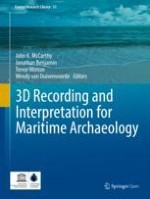
Open Access 2019 | OriginalPaper | Buchkapitel
11. Resolving Dimensions: A Comparison Between ERT Imaging and 3D Modelling of the Barge Crowie, South Australia
verfasst von : Kleanthis Simyrdanis, Marian Bailey, Ian Moffat, Amy Roberts, Wendy van Duivenvoorde, Antonis Savvidis, Gianluca Cantoro, Kurt Bennett, Jarrad Kowlessar
Erschienen in: 3D Recording and Interpretation for Maritime Archaeology
Aktivieren Sie unsere intelligente Suche, um passende Fachinhalte oder Patente zu finden.
Wählen Sie Textabschnitte aus um mit Künstlicher Intelligenz passenden Patente zu finden. powered by
Markieren Sie Textabschnitte, um KI-gestützt weitere passende Inhalte zu finden. powered by